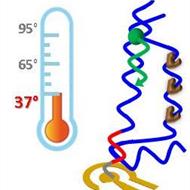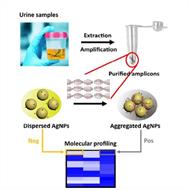
Duplex lateral flow assay for the simultaneous detection of Yersinia pestis and Francisella tularensis.
Author: Jauset-Rubio M, Tomaso H, Soror El-Shahawi M, Saleh Omar Bashammakh A, Obaid Al-Youbi A, O’ Sullivan CK.
The multiplexed amplification detection of genomic DNA from Francisella tularensis and Yersinia pestis is reported here. Amplification was achieved using isothermal recombinase polymerase amplification (RPA), exploiting tailed primers, followed by detection using a nucleic-acid lateral flow assay.

Detection of Babesia gibsoni in dogs by combining recombinase polymerase amplification (RPA) with lateral flow (LF) dipstick.
Author: Cui J, Zhao Y, Sun Y, Yu L, Liu Q, Zhan X, Li M, He L, Zhao J.
The novel LF-RPA assay is effective for the detection of B. gobsini and has considerable advantages over the conventional PCR in sensitivity, specificity, simplicity in operation, less time consumption, and visual detection. The LF-RPA method may facilitate the surveillance and …

On‐gold recombinase polymerase primer elongation for the electrochemical detection of bacterial genome: mechanism insights and influencing factors.
Author: Sánchez-Salcedo R, Miranda-Castro R, de-los-Santos-Álvarez N, Jesus Lobo Castañón M.
Here, an on‐chip isothermal recombinase polymerase amplification (RPA) with chronoamperometric detection, which could be run with simple equipment was optimised. A short thiol‐modified oligonucleotide, complementary to a fragment of bipA gene of Salmonella spp., is chemisorbed onto the gold chip …

“Mix-to-Go” Silver Colloidal Strategy for Prostate Cancer Molecular Profiling and Risk Prediction.
Author: Wang J, Koo KM, Wang Y, Trau M.
Herein, is proposed a “mix-to-go” colloidal strategy which utilizes the electrostatic attraction between negatively charged target sequences and positively charged silver nanoparticles (AgNPs) to induce aggregation of AgNPs, to profile a panel of clinically-validated urinary prostate cancer (PCa) RNA biomarkers …

Rapid detection of avian influenza A virus (H7N9) by lateral flow dipstick-recombinase polymerase amplification.
Author: Ma S, Li X, Peng B, Wu W, Wang X, Liu H, Yuan L, Fang S, Lu J.
In this study, a lateral flow dipstick recombinase polymerase amplification (LFD-RPA) assay for rapid detection of both hemagglutinin and neuraminidase gene of H7N9 was developed and evaluated. The H7-LFD-RPA and N9-LFD-RPA assay were able to detect 32 fg H7N9 nucleic …

Low-Cost Detection of Norovirus Using Paper-Based Cell-Free Systems and Synbody-Based Viral Enrichment.
Author: Ma D, Shen L, Wu K, Diehnelt CW, Green AA.
Herein is demonstrated a low-cost colorimetric assay that detects norovirus from clinical samples by combining paper-based cell-free transcription-translation systems, isothermal amplification, and virus enrichment by synbodies. Using isothermal amplification and cell-free RNA sensing with toehold switches, it was demonstrated that …

Recombinase Polymerase Amplification Assay for Field Detection of Tomato Bacterial Spot Pathogens.
Author: Strayer-Scherer AL, Jones LB, Paret ML.
Recombinase polymerase amplification (RPA) is ideal for in-field detection assays because it is an isothermal technique that is rapid and more tolerant to inhibitors compared to PCR. Hence, novel RPA probes and primers were designed to amplify regions of the …

High-specificity Double-stranded DNA Detection with “Humanoid” Molecular Beacon and TALEs.
Author: Wang Y, Bai LJ, Qu X, Gao Y, Wang J, Li S, Fan L, Wei H, Liu S, Peng Y, Gao Z, Zhu Y, Gao Z, Ning B.
Owing to the limitation of DNA-specific recognition, improving the sensitivity of bacteria detection without additional culture poses a considerable challenge. Herein, a sensitive, novel, and high-specificity fluorescence detection method was developed using transcription activator-like effectors (TALEs) as the specifically recognized …

Recombinase Polymerase Amplification Combined with Unmodified Gold Nanoparticles for Salmonella Detection in Milk.
Author: Chen ZG, Zhong HX, Luo H, Zhang RY, Huang JR.
In this study, isothermal recombinase polymerase amplification (RPA) was combined with unmodified gold nanoparticles (AuNPs) to detect Salmonella in milk. A rapid, effective, visualized, and low-cost RPA-AuNP assay was developed, with a detection limit of 50 CFU for milk samples …

Isothermal DNA amplification combined with lateral flow dipsticks for detection of biothreat agents.
Author: Zasada AA, Zacharczuk K, Forminska K, Wiatrzyk A, Ziolkowski R, Malinowska E.
In the presented study three methods of isothermal DNA amplification loop-mediated isothermal amplification (LAMP), recombinase polymerase amplification (RPA) and thermophilic helicase-dependent isothermal DNA amplification (tHDA), were compared for detection of highly dangerous pathogens, such as Bacillus anthracis, Francisella tularensis and …

